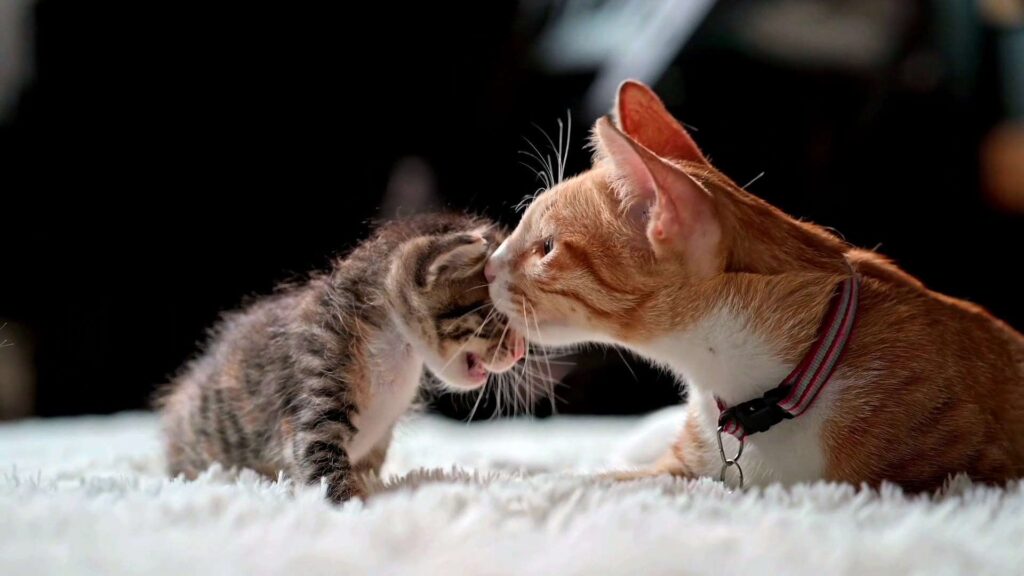Can Female Cats Kill Another Cat’s Kittens? The Answer May Surprise You

Wondering whether or not cats kill another cats kittens? Read and find out!
Cats are known for their independent and often solitary nature, but they can also be social creatures that form strong bonds with their companions. However, sometimes the social dynamics among cats can become complicated, especially when it comes to raising and protecting kittens. Can this complication cause female cats to kill another cats kittens?
In this blog post, we’ll explore the question of whether female cats can kill another cat’s kittens and what factors may contribute to this behavior.
Can Female Cats Kill Another Cat’s Kittens?
Cats are natural hunters and predators, with instincts that drive them to hunt and kill prey. In the wild, female cats kill another cats kittens in order to eliminate competition for resources. This behavior is known as infanticide.
Infanticide can also occur in domesticated cats, although it is less common. There are several factors that may lead to female cat infanticide, including territorial behavior, stress, and lack of resources.
Research has shown that female cats may also be more likely to kill kittens that are not their own, particularly if they are not spayed or neutered. This is because unaltered cats are more likely to exhibit aggressive and territorial behavior.
While infanticide is not common in domesticated cats, it can still occur in certain situations. For example, a female cat may attack and kill the kittens of another cat if they feel that their own kittens are in danger or if they are feeling threatened.
Understanding Mother Cats and Kittens

Female cats are known for their maternal instincts and often make excellent mothers to their own kittens. They are generally very attentive and protective, providing warmth and nourishment to their offspring. However, when it comes to other cats’ kittens, the situation can be more complicated.
In some cases, female cats may tolerate or even care for other cats’ kittens. This behavior is more common among females who are related or familiar with each other. This is because they may view the kittens as part of their own family. However, in other cases, female cats may view other cats’ kittens as a threat. Causing them to attack or even kill them.
Cats are territorial creatures, both in the wild and in domestic settings. Fighting over territory is a common occurrence, especially among male cats. However, when a female cat is expecting a litter of kittens, the situation changes. Other cats, including females in multi-cat households, may act aggressively toward the new kittens, possibly feeling threatened in some way.
In some cases, even mothers may act in hostility toward one or more kittens in the litter. This behavior is known as maternal aggression and can be caused by various factors. These factors include stress, hormonal imbalances, and/or health issues. Maternal aggression can result in serious harm to the affected kittens, including injury or even death.
While it is rare for other cats to harm newborn kittens, it can happen due to territorial threats or a mother rejecting an unwell newborn. Therefore, it is important to keep a new mother and her kittens in a private space. Atleast until they are old enough to socialize with adult cats. This can help to minimize the risk of harm and ensure the health and well-being of the kittens.
Why Do Female Cats Kill Another Cats’ Kittens?

There are several reasons why a female cat may kill another cat’s kittens. Let’s explore some of the most common reasons below.
Territorial Instincts
One of the main reasons why a female cat may kill another cat’s kittens is territorial instincts. Female cats are known to be protective of their offspring. So they may perceive other cats’ kittens as a potential danger to their own litter.
The instinct to protect their offspring is essential for ensuring their survival in the wild. This is also true for domestic cats. If another cat’s kittens enter their territory, a female cat may view them as a threat to her own litter and take aggressive action to eliminate the perceived danger.
It is worth mentioning that the risk is higher with feral cats, as compared to neutered and indoor cats. Indoor cats are more sociable, and more likely to accept another cat’s kittens. In fact, there are even cases where a mother cat will adopt another cats kittens, and treat them as her own.
Competition for Resources
Competition for resources is a significant factor that can lead to aggression and even infanticide in female cats. When resources such as food, shelter, or attention are limited, a female cat may perceive the presence of another cat’s kittens as a threat to the well-being of her own offspring. In an effort to ensure the survival and success of her own litter, she may resort to aggressive behavior, including attacking and even killing the competing kittens.
This behavior is instinctual and rooted in the primal drive for survival and reproduction. Female cats are driven to protect and provide for their own offspring, as this increases the chances of their genetic line continuing. By eliminating competition from other kittens, the female cat aims to secure more resources for her own litter, ensuring their survival and giving them a better chance to thrive.
It is important to note that not all female cats exhibit this behavior, and it may be influenced by various factors such as the availability of resources, social dynamics, and individual temperament. Additionally, interventions such as early spaying and neutering can help prevent unwanted litters and minimize the occurrence of resource-based aggression in female cats.
Protecting Her Own Offspring
Protecting her own offspring is one of the primary reasons why a female cat may kill another cat’s kittens. Female cats are known for being fiercely protective of their own offspring, and they may perceive other cats’ kittens as a threat to their own.
It’s important to note that a female cat’s protective instincts may be triggered even if her own kittens are not present. This is because female cats are programmed to protect all kittens, not just their own. Therefore, even if a female cat doesn’t have any kittens of her own, she may still attack and kill another cat’s kittens if she perceives them as a threat.
Injury or Illness
Sometimes, a female cat may kill another cat’s kittens if they are injured or ill. This may be an instinctual response to remove weak or sickly members from the group. This helps to ensure the survival of the stronger members. From an evolutionary standpoint, this behavior can be seen as a way to protect the group as a whole and increase the chances of survival for healthy offspring.
However, it is important to note that not all female cats will exhibit this behavior, and it is not a universal explanation for why female cats may kill other cats’ kittens. Additionally, sometimes a female cat may attack a healthy kitten for no apparent reason, which can be attributed to aggression or other factors.
Preventing Female Cats from Killing Another Cats’ Kittens

If you have multiple cats in your household or encounter other cats in your community, it’s important to take steps to prevent female cats from killing other cats’ kittens. Here are some strategies you can use to reduce the risk of this behavior.
Spay and Neuter Your Cats
Spaying and neutering cats is one of the most effective ways to prevent female cats from killing other cats’ kittens. Spaying and neutering refer to the surgical removal of a female cat’s ovaries and uterus or a male cat’s testicles, respectively.
When cats are spayed or neutered, their hormones change, which can significantly reduce their territorial and aggressive behaviors. Female cats, in particular, become less likely to display maternal aggression towards other cats’ kittens.
Introduce Cats Slowly
Introducing cats slowly is an essential step to prevent female cats from killing other cats’ kittens. It is important to give each cat their space and gradually introduce them to each other over several days or even weeks. This helps to prevent aggression and allows cats to adjust to each other’s presence.
Additionally, it is important to supervise all interactions between cats, especially during the initial introduction phase. This can help prevent any negative interactions and allow for early intervention if necessary. By following these steps, pet owners can help ensure a peaceful and safe environment for all cats in their household.
Provide Enough Resources
Providing enough resources is an essential step to prevent female cats from killing other cats’ kittens. When cats feel that they have access to sufficient resources such as food, water, and litter boxes, they are less likely to display aggressive behavior. It is recommended to provide separate resources for each cat, especially for mother cats with kittens, to avoid competition and territorial disputes.
In a multi-cat household, it is crucial to have enough resources for each cat to minimize the chances of aggression. It is also important to place the resources in different areas of the house to avoid conflicts and territorial disputes. Each cat should have its own litter box, water bowl, and food bowl in a separate location.
Supervise Interactions
Supervising interactions between cats is an important step in preventing female cats from killing other cats’ kittens. This is especially important when introducing a new cat or kitten into a multi-cat household.
During supervised interactions, it is important to watch the cats closely for any signs of aggression or tension. These can include hissing, growling, raised fur, and swatting. If any of these signs are observed, it is best to separate the cats immediately to prevent any harm.
Supervision is also important when introducing kittens to adult cats, even if the adult cat is the mother. Adult cats may view the new kittens as a threat to their resources or territory and may act aggressively towards them.
Conclusion
In conclusion, female cats may kill another cat’s kittens for a variety of reasons, including territorial instincts, competition for resources, and protecting their own offspring. Understanding feline social dynamics and taking steps to prevent aggressive behavior can help reduce the risk of this behavior and ensure that all cats in your household are happy and healthy.
By spaying and neutering your cats, introducing cats slowly, providing enough resources, and supervising interactions, you can help create a peaceful and harmonious household for all of your feline companions. Remember to always monitor your cats’ behavior and seek the advice of a veterinarian or animal behaviorist if you notice any signs of aggression or territorial behavior.


